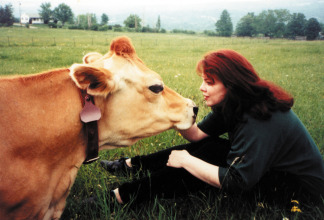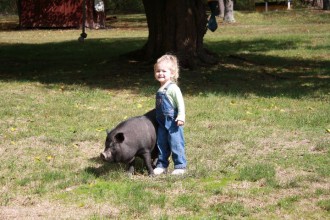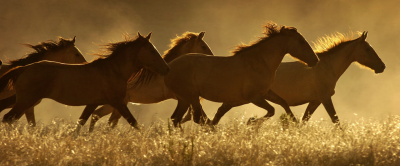
Itching for a trip that takes you beyond the usual lazy day at the beach? If so, you’re in good company. Many of today’s travelers are turning to vacations that have a deeper purpose — where the reward of making a difference in life far outweighs a suitcase of souvenirs.
There are numerous sanctuaries across the country that depend on the big hearts and dedicated efforts of volunteers to maintain operations. From pet rescues to farm sanctuaries, these organizations have a lot of work to do — and you can help them! Definitely not your average R&R, volunteering can be grueling work. After all, there are barns to clean, hungry animals to feed and facilities to upkeep. Challenging yourself to do something beyond the ordinary can be a great personal experience, and seeing your efforts pay off in the happiness of grateful animals is a reward like no other. For those ready to take vacationing to the next level, here are my top three picks in the animal sanctuary kingdom.
Best Friends Animal Sanctuary: Kenab, Utah
Best Friends is the country’s largest animal sanctuary. Located in the heart of the Golden Circle of National Parks in Kenab, Utah it houses over 1,800 animals at a time! From the 650 dogs in ‘Dog Town’ to the cats, rabbits, horses, burros, birds and pigs that call the 3,000 acre sanctuary-home, the staff certainly has their work cut out for them. This is why they rely heavily on the kindness of volunteers.

According to Volunteer Coordinator Jean Morris, 20,000 people visit the sanctuary every year, and of those, 3,500 stay to help out with the massive amount of daily chores. Barbara Williamson, Media Relations Manager for Best Friends comments, “Some guests contribute a few hours, others work for days or weeks. We’ve had couples volunteer on their honeymoon, a woman who celebrated her 94th birthday by cleaning cat boxes and school kids who come play with and help out the animals in return for getting good grades. Some even come in memory of a beloved pet that has passed away.” Whatever the reason, Best Friends is always thrilled when guests are willing to roll up their sleeves and get down to work.
Cindy and Travis Hysell of St. George, UT have been volunteering at Best Friends for seven years. “It’s a great way to be together as a family,” says Cindy Hysell. “It’s a lot of fun and its just good therapy for all of us to get away from everyday life and come out here together.” She adds that it’s also a wonderful way to teach children to be kind to animals and responsible pet guardians. “One of the things I like best about Best Friends is that they have a lot of education programs there. They go into schools and host field trips and teach people about these animals and how to be compassionate and responsible. It’s just an amazing place.”
Best Friends offers free, guided tours daily, and there is a welcome center and gift shop for browsing. Eight Angel Canyon Guest Cottages ($125/night) are nestled among the red cliffs that overlook the sanctuary’s sprawling horse pastures.
www.bestfriends.org
Farm Sanctuary: Watkins Glen, New York & Orland, California
In 1986, Gene and Lori Bauston found a live sheep sick and abandoned atop a stockyard ‘dead pile’. They rescued her, named her Hilda, and decided to devote their lives to helping other abused and neglected farm animals. Eighteen years later, Farm Sanctuary is at the forefront of factory farm protest and animal rescue. This 175-acre farm in upstate New York, and 300-acre compound in northern California provides rescued animals with the security and love they’ve never known.
Unlike many sanctuaries, the farm does have a regular care staff for the animals — roughly thirty-five staff members at the New York facility, and fifteen in California. However, there is still plenty of work for volunteers! “Volunteers are needed most to help clean out barns and things like that,”explains Erin Flowers, the farm’s Intern & Volunteer Coordinator. “However, if someone wants to volunteer but is physically unable to clean and perform physical labor, we try to set them up on a mailing project such as stuffing envelopes. Even with our staff, volunteers are an important part of the work we do here.” The internship program also brings in at least six interns a month.
However, a trip to the farm doesn’t mean all work and no play! Annual events include the Country Hoe Down (boot-stompin’ music and all-vegan barbeque), an Independence Day ‘Pig’-nic, and a Thanksgiving Celebration for the Turkeys– where visitors feed the feathered guests of honor.
The farm makes vacationing a real treat with its ‘Barn & Breakfast’ concept. Wake up in a charming red country cottage ($75/night) to the sound of roosters crowing, take in the breathtaking natural scenery, and then chow down on a continental vegan breakfast. Visitors can also browse a gift shop and enjoy a complimentary farm tour.
www.farmsanctuary.org
Pigs Peace Sanctuary: Stanwood, Washington
When the pot-bellied pig fad swept the nation in the mid 80’s, no one seemed to give much thought to what would happen to these gentle, intelligent creatures once the novelty wore off and the rigors of pig parenting took a toll. Unfortunately, what did happen was unthinkable; since most animal shelters considered pot-bellied pigs to be livestock rather than pets, most of these former pets were sent for slaughter. That is, until Judy Woods founded Pigs Peace in 1994 and gave piggies everywhere a second chance to squeal!
“It’s really sad that these animals are blindly taken in as pets, and when they are considered no longer worth the trouble, they’re just sent off to slaughter to become food,” says Woods, the Sanctuary Director.
While Woods rescues many of her pigs from auctions, others come from homes where they’ve been terribly neglected or mistreated. Rescued in December 2003, piglet Winston had been living in a tiny birdcage. Another piglet had grown through the straps of a cat harness, while others have been found living in everything from dump yards to bedroom closets.
It’s understandable that many of these animals are fearful and sometimes aggressive after coming from such horrific conditions. “My days are busy with the work of repairing emotional trauma and physical abuse,” Woods says. “Sometimes that takes hundreds of hours of work.” Such was the case of Rosie, now ten years old. After being abandoned in a stall after her caretakers got a divorce, Rosie became extremely aggressive and would charge anyone who came near her. Woods wouldn’t give up and, after a lot of patience and TLC, her efforts paid off. “She’s a ‘people pig’ now,” Woods chuckles. “She’s become very sweet and greets all the visitors.”

Since she doesn’t have a work staff, Woods relies on volunteers to keep the shelter running. She sees one to several volunteers daily, but it’s her monthly work parties that get the majority of the jobs done. “We usually have a turnout of fifty-sixty people, and it’s great because we can really get a lot done together. I couldn’t do it without the volunteers.” Out-of-towners can “camp out” on the grounds or in the on-site education center, which features showers, a fridge and microwave, dining tables and a wood stove. A two-bed guest room is currently being built as well.
www.pigspeace.org
Return to Freedom: The American Horse Sanctuary

Return to Freedom offers a variety of volunteer opportunities for horse lovers and others You can lend a hand for a couple of hours, join in for a volunteer work day or camp out with your family for a volunteer work weekend or live on site. Whatever your availability and skills, Return To Freedom is always happy to welcome volunteers!
Return to Freedom was founded in 1997 by Neda DeMayo and is dedicated to preserving the freedom, diversity and habitat of America’s wild horses. The foundation operates on a 300-acres ranch in California and is home of 400 horses and burros. The herds live in large pastures where they are free to keep their natural social structures and behaviors.
The foundation recommends that volunteers start their journey by attending one of our volunteer orientation days which are scheduled on the second Saturday of every month. The day starts at 9 am, is punctuated by a long lunch and a complimentary tour is given to thank the volunteers at the end of the day. This is the best way to get introduced to the work of the foundation, and this is non-committing.
Return to Freedom also organizes Volunteer Weekend Campouts in the summer months, particularly fun for families and large groups. Participants take part in the regular volunteer day, and finish off with a barbecue around a campfire. On Sunday morning, children are often invited to help with the morning feeding and other chores before everyone packs up and leaves around 1pm.
On Sundays, Return to Freedom holds the “Manure Scooping Days” to help dispose of the droppings of 300 horses of the sanctuary. Not very glamorous but a necessary job!
Apart from these volunteer days, Return to Freedom is always seeking Weekly Administration Volunteers to help run the ranch, Equine Volunteers to care for the horses and Skilled Volunteers such as ranchers, electricians, plumbers, carpenters, etc.
Visit their website to learn more or email at volunteers@returntofreedom.org.
International Center for Gibbon Studies, Santa Clarita, California

For animal lovers who want a close and personal experience with wild and rare primates, the International Center for Gibbon Studies is made for you! Volunteers are expected to work hard on behalf of the nearly 40 gibbons who live at the center. “These animals are extremely endangered,” explains Patricia Dahle, volunteer coordinator. “There are six or seven species in Asia, and they’re all in trouble.” Volunteers are expected to feed and give water to the animals, medicate them when needed, clean the enclosures, participate in research and behavioral observations, as well as helping with maintenance and office work. “Most people come because they want to learn about the animals and to be close to them.” Dahle says. “We are absolutely dependent on the volunteers.”
The Gibbon Conservation Center was founded in 1976 by Alan Richard Mootnick and is the only institution in the world to house and breed all four genera of gibbon. The center has successfully bred 7 species of gibbons and provides non invasive learning and research possibilities for students and scientists.
Volunteers who wish to participate to the Volunteer Assistant Caregiver program (assist with food preparation, observation, creating enrichment, cleaning, yard work etc.) are required to stay at least one month, and a fee of $300 for the first month and shared rustic housing is required as part of the fee. For the Volunteer Caregiver program (fulfill all caregiver requirements including food preparation, feeding and clean-up), fees are $500 for the first 2 months and shared housing is provided as part of your fee.
Summers fill up quickly, so you’ll need to plan in advance if you’d like to visit during July or August!
Caribbean Canines: Animal Care Projects, in Vieques Island, Puerto Rico

In the beautiful island of Puerto Rico, the numerous stray dogs are called sato. The majority of them come from the US and are not spayed or neutered, causing a serious problem of over-population. After a visit to the island, Debbie Jacobs of Explorations in Travel was so moved by these animals’ terrible living conditions that she started a volunteering and visitation program to try and help them. Explorations in Travel organizes short and long term trips for volunteers who want to lend a hand to the permanent staff who is often overwhelmed by the huge number of canines in need.
Volunteer groups stay at a hotel in San Juan, only a short walk from the beach. The first day includes planning activities for the training events and a visit to a local shelter where you will adopt a sato, who will become the demo dog and will show people that shelter dogs make wonderful pets! At the end of the program, the lucky pooch will be taken to the US where to meet his new family and forever home!
The groups include dog trainers who want to share reward-based training practices with pet parents, rescue groups and shelter staff on the islands of Puerto Rico and Vieques. This journey will take you from the rainforest to paradise-like beaches and you might even learn a few steps of salsa!
Costs are $1299, including all lodging (based on double occupancy), ground & water transportation in Puerto Rico & Vieques, 5 dinners, 2 lunches, 2 breakfasts, tips & gratuities. There is a single supplement of $250.
For the Best the Pet Lifestyle and health has to offer follow Wendy Diamond on Facebook, Twitter, and right here at AnimalFair.com!

